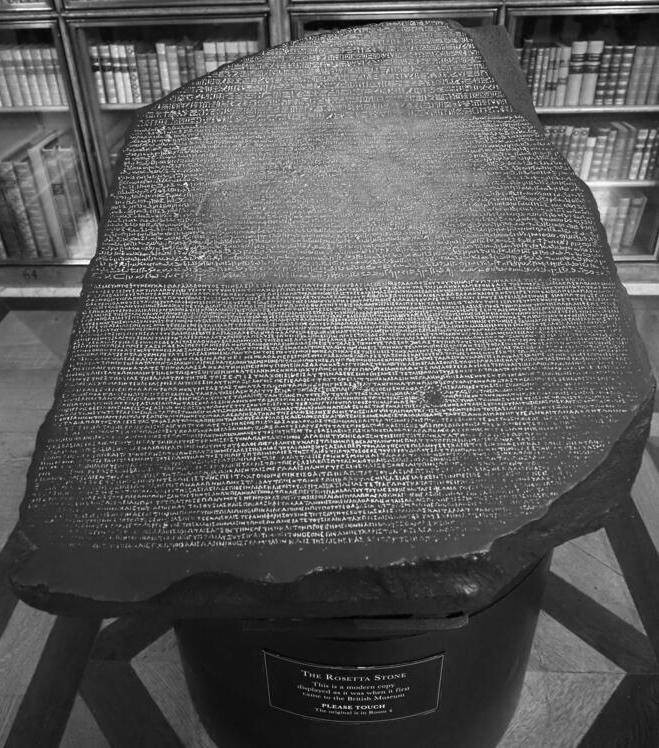
The Rosetta Stone is a granodiorite stele, found in 1799, inscribed with three versions of a decree issued at Memphis, Egypt in 196 BC during the Ptolemaic dynasty on behalf of King Ptolemy V. The top and middle texts are in Ancient Egyptian using hieroglyphic script and Demotic script, respectively, while the bottom is in Ancient Greek. As the decree has only minor differences between the three versions, the Rosetta Stone proved to be the key to deciphering Egyptian hieroglyphs.
The stone, carved in black granodiorite during the Hellenistic period, is believed to have originally been displayed within a temple, possibly at nearby Sais. It was probably moved during the early Christian or medieval period, and was eventually used as building material in the construction of Fort Julien near the town of Rashid (Rosetta) in the Nile Delta. It was rediscovered there in July 1799 by a French soldier named Pierre-François Bouchard during the Napoleonic campaign in Egypt. It was the first Ancient Egyptian bilingual text recovered in modern times, and it aroused widespread public interest with its potential to decipher this previously untranslated hieroglyphic language. Lithographic copies and plaster casts began circulating among European museums and scholars. Meanwhile, British troops defeated the French in Egypt in 1801, and the original stone came into British possession under the Capitulation of Alexandria and was transported to London. It has been on public display at the British Museum almost continuously since 1802, and is the most-visited object there.
Study of the decree was already under way when the first full translation of the Greek text appeared in 1803. It was 20 years, however, before the transliteration of the Egyptian scripts was announced by Jean-François Champollion in Paris in 1822; it took longer still before scholars were able to read Ancient Egyptian inscriptions and literature confidently. Major advances in the decoding were recognition that the stone offered three versions of the same text (1799); that the demotic text used phonetic characters to spell foreign names (1802); that the hieroglyphic text did so as well, and had pervasive similarities to the demotic (Thomas Young, 1814); and that, in addition to being used for foreign names, phonetic characters were also used to spell native Egyptian words (Champollion, 1822–1824). Wikipedia, Rosetta Stone
The Rosetta Stone is widely considered one of archaeology's most significant finds. A decree from Egyptian Pharaoh Ptolemy V carved in 196 BCE, the stone is inscribed with three distinct languages: ancient Greek, Demotic or an ancient Egyptian script, and hieroglyphics — a language that had been lost since the 4th century. Using the other two inscriptions on the stone, researchers were able to decipher the hieroglyphics, reviving a once dead language.
But as much as it is an object of significance, the stone is today one of controversy. While it is currently in the hands of the British, many Egyptians believe it belongs in their galleries. "The Rosetta Stone is the icon of Egyptian identity," Egypt's antiquities minister said. "The British Museum has no right to show this artifact to the public."
Learn more about the history of the Rosetta Stone: https://bit.ly/3SHbqI6
